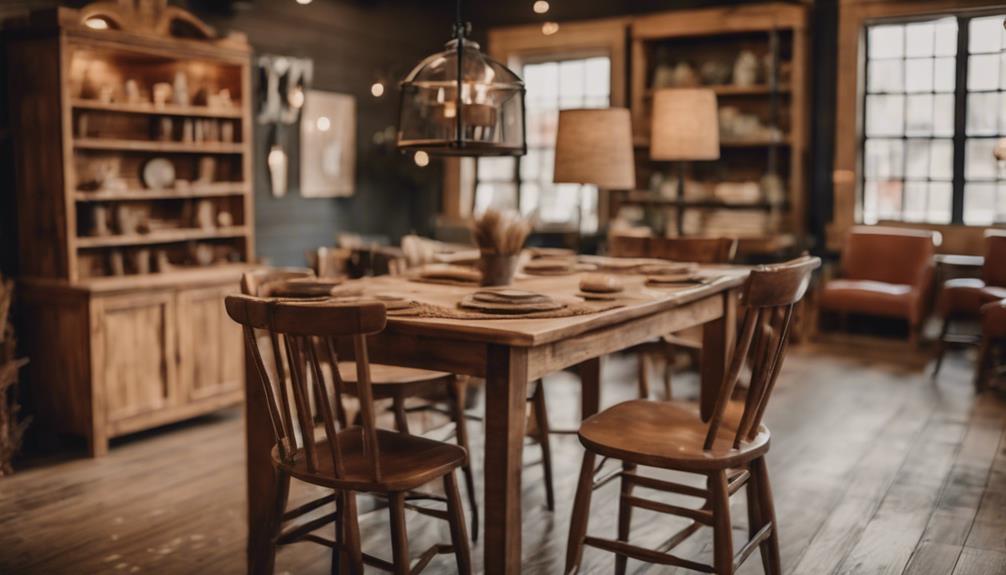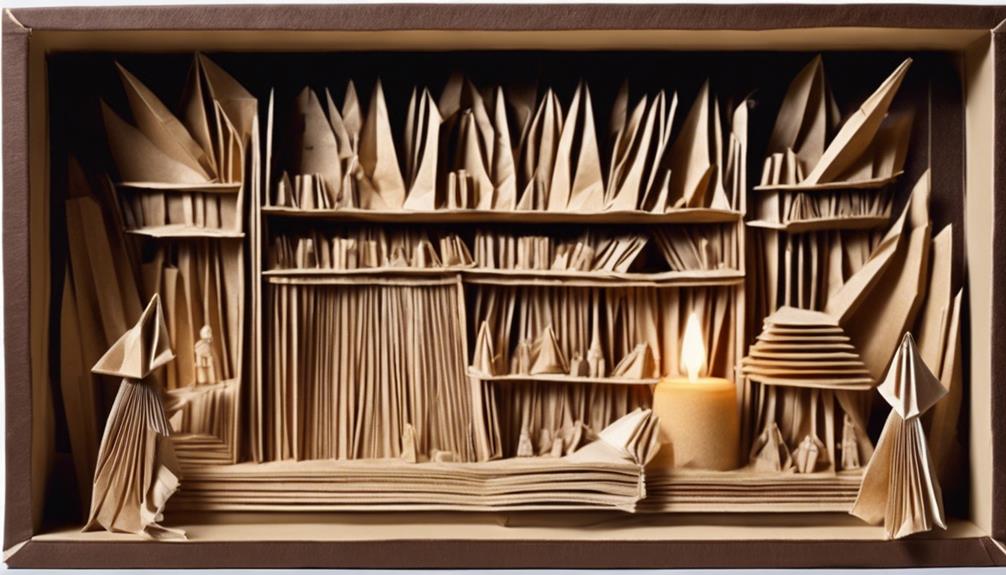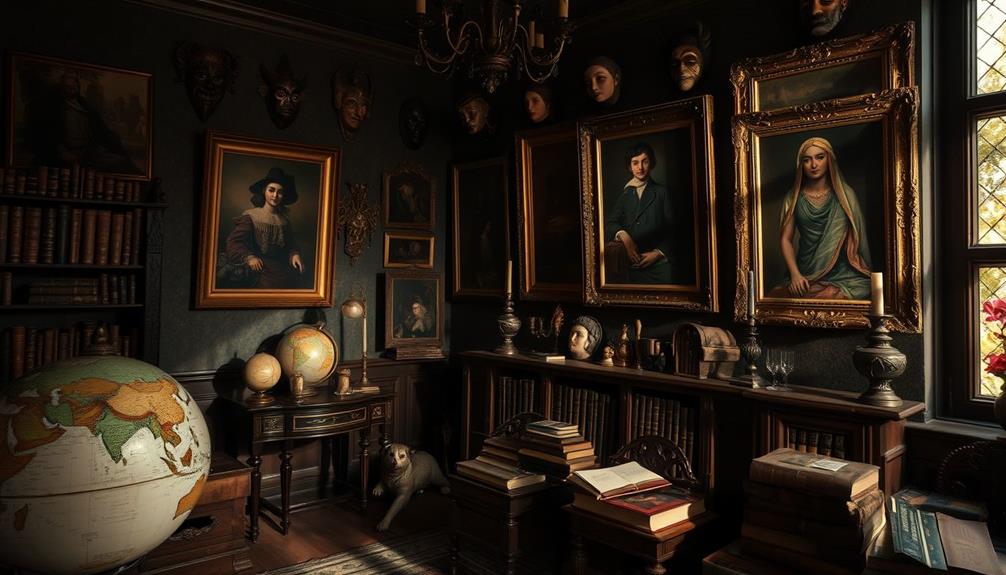Shaker furniture, rooted in 18th-century beliefs of simplicity and craftsmanship, stands out for its enduring elegance and functional design. Crafted from local woods like cherry and pine, Shaker pieces feature minimalist styles and sturdy joinery, such as mortise and tenon joints. Iconic pieces like ladder-back chairs and rocking chairs showcase advanced woodworking techniques, reflecting a blend of form and function. This furniture tradition emphasizes quality, durability, and sustainability, making it a timeless addition to any home. For those seeking lasting beauty and practicality, Shaker furniture offers a harmonious balance between classic craftsmanship and modern appeal, enriching interior spaces.
Key Takeaways
- Shaker furniture embodies timeless elegance and functionality.
- Integrates seamlessly into diverse interior design styles.
- Crafted with traditional techniques for durability and longevity.
- Modern interpretations blend classic craftsmanship with contemporary elements.
- Authentic pieces can be sourced from museums, antique stores, and dedicated furniture makers.
Origins of Shaker Furniture
The origins of Shaker furniture can be traced back to the United Society of Believers in Christ's Second Appearing, commonly known as the Shakers. This religious sect, founded in the 18th century, believed in leading a simple and humble life, reflecting their values through all aspects, including furniture design.
For the Shakers, form followed function; they viewed furniture-making as a form of worship and prayer, emphasizing practicality and utility over ornate decoration.
Crafted by skilled artisans within Shaker communities, the furniture pieces were characterized by their minimalist aesthetic and high-quality craftsmanship. Using locally sourced woods such as cherry, pine, and maple, the Shakers created durable and timeless pieces that served their intended purpose effectively.
Their commitment to simplicity and functionality not only influenced their own lifestyle but also left a lasting impact on design movements that followed, such as modernism and the arts and crafts movement.
Design Philosophy of Shaker Style

Originating from the religious beliefs and values of the Shakers, the design philosophy of Shaker style furniture embodies a commitment to functional simplicity and minimalism. This approach is deeply rooted in the following design principles and woodworking techniques:
- Minimalist Design: Shaker style emphasizes clean lines and a lack of unnecessary ornamentation, focusing on practicality and functionality over decorative elements.
- Honest Craftsmanship: Solid domestic woods like Maple and Cherry are meticulously selected for their durability and natural beauty, reflecting the Shakers' dedication to honesty and integrity in woodworking.
- Signature Joinery: Shaker furniture often features doors crafted with mortise and tenon joinery, a technique known for its strength and longevity. This joinery method not only upholds the structural integrity of the furniture but also adds a touch of elegance to the pieces.
These design principles and woodworking techniques combine to create furniture pieces that not only stand the test of time but also exude a timeless charm that complements a variety of interior styles.
Crafting Techniques and Joinery

Crafting techniques and joinery in Shaker furniture showcase a blend of advanced woodworking methods and meticulous attention to detail. Shakers utilized techniques such as dovetail and mortise and tenon joints, known for their strength and aesthetic appeal. These methods were integral to the construction of Shaker furniture, emphasizing durability and longevity in every piece.
The Shakers' unwavering attention to detail went beyond mere craftsmanship; they believed that the quality of their work reflected their dedication to God.
Innovations like the adoption of labor-saving devices such as circular saws allowed the Shakers to streamline their furniture-making process while maintaining their commitment to traditional woodworking practices. This dedication to quality craftsmanship ensured that Shaker furniture wasn't only visually appealing but also built to withstand the test of time.
The meticulous joinery and craftsmanship found in Shaker furniture exemplify a timeless art form that continues to captivate admirers with its blend of functionality and beauty.
Iconic Shaker Furniture Pieces

Shaker furniture pieces, renowned for their simplicity and functionality, encompass iconic designs that have stood the test of time. The following list highlights some of the most notable pieces in the world of Shaker furniture:
- Ladder-back chairs with woven seats: These chairs are a quintessential representation of Shaker style, known for their clean lines, sturdy construction, and practical woven seats.
- Rocking chairs: Shakers were pioneers in mass-producing rocking chairs in the U.S., showcasing their advanced woodworking techniques and commitment to comfort and craftsmanship.
- Use of local woods: Shaker furniture often incorporates local woods like cherry, maple, and pine, reflecting the Shakers' dedication to using high-quality materials sourced from their surroundings.
This emphasis on local resources not only adds to the durability of the pieces but also ties them closely to their cultural and environmental roots.
Timeless Appeal of Shaker Designs

Shaker furniture's enduring appeal stems from its minimalist aesthetics that prioritize functional simplicity in design.
The clean lines and balanced proportions of Shaker pieces exude a timeless elegance that transcends passing trends.
Crafted with meticulous attention to detail, these furniture items showcase a harmonious blend of form and function that continues to attract admirers seeking enduring beauty in their living spaces.
Minimalistic Shaker Aesthetics
With its timeless allure rooted in simplicity and functionality, the minimalistic aesthetics of Shaker furniture continue to captivate admirers across various design preferences. Shaker furniture is known for its minimalist design, focusing on functional simplicity and clean lines.
Here are three reasons why the minimalist aesthetics of Shaker furniture stand out:
- Emphasis on Functionality: Shaker aesthetics prioritize functionality over unnecessary embellishments, ensuring that each piece serves a practical purpose while maintaining a sleek appearance.
- Natural Beauty of Wood: Shaker designs highlight the natural beauty of wood, showcasing the quality craftsmanship and allowing the material to shine without the need for elaborate ornamentation.
- Versatile Style: The timeless appeal of Shaker furniture transcends design boundaries, effortlessly blending with modern, traditional, and eclectic decor styles to create a harmonious atmosphere in any living space.
Functional Simplicity in Design
Exemplifying a commitment to form and utility over unnecessary embellishments, Shaker designs have long been celebrated for their functional simplicity. Shaker furniture embodies a design style that prioritizes practicality and clean aesthetics. This approach emphasizes the essence of each piece, focusing on quality craftsmanship and attention to detail rather than ornate decoration.
The timeless appeal of Shaker furniture lies in its ability to blend seamlessly into various interior styles, from traditional to modern, due to its minimalist aesthetic. By staying true to the principles of simplicity and utility, Shaker designs have stood the test of time, becoming a staple in the world of furniture.
The enduring popularity of Shaker furniture can be attributed to its versatility and classic charm, making it a sought-after choice for those seeking a blend of functionality and elegance in their living spaces. Shaker furniture's design philosophy continues to influence contemporary furniture makers, showcasing the enduring legacy of this timeless design style.
Incorporating Shaker Furniture in Interiors

Integrating Shaker furniture into interior spaces effortlessly enhances the overall aesthetic and functionality of a room. When incorporating Shaker furniture into interior design, consider the following:
- Versatility: Shaker furniture seamlessly blends into various interior decor styles, including traditional, coastal, Scandinavian, and eclectic designs, offering a timeless and classic touch to any room.
- Craftsmanship: Crafted with mortise and tenon joinery from solid domestic woods like Maple and Cherry, Shaker style doors provide a perfect balance of understated beauty and functionality, showcasing the craftsmanship and integrity of Shaker design principles.
- Classic Charm: Shaker doors, available in sliding, swinging, and entry styles, feature different panel numbers and types, such as flat or tongue and groove, adding a touch of classic charm to interiors while embodying the simplicity and honesty that define Shaker furniture.
Incorporating Shaker furniture into interiors not only adds a touch of timeless elegance but also brings functionality and craftsmanship to living spaces.
Modern Interpretations of Shaker Art

Modern designers frequently infuse traditional craftsmanship with contemporary elements when reinterpreting Shaker art. Drawing inspiration from the principles of simplicity and functionality that define Shaker furniture, modern interpretations seamlessly blend classic techniques with modern style furniture trends. These contemporary pieces often feature sleek lines, minimalist aesthetics, and the use of sustainable materials, reflecting a commitment to both design innovation and environmental consciousness.
The timeless style of Shaker furniture enables it to harmoniously fit into various interior design styles, making it a versatile choice for modern homes. By incorporating elements of Shaker art into their designs, furniture designers create pieces that showcase a balance between classic craftsmanship and modern sensibilities. This fusion of past and present not only pays homage to the rich tradition of Shaker furniture-making but also brings a fresh perspective to the world of interior design.
Maintaining and Caring for Shaker Furniture

Regular maintenance is crucial to preserve the beauty and longevity of Shaker furniture pieces. To guarantee your Shaker furniture remains in top condition, follow these key maintenance tips:
- Dust Regularly: Use a soft cloth to gently remove dust and prevent the accumulation of dirt and grime that can dull the wood's finish.
- Avoid Harsh Chemical Cleaners: Protect the natural wood finish by refraining from using harsh chemical cleaners that can strip away the wood's protective coating.
- Protect from Sunlight and Temperature: Prevent fading and warping by keeping Shaker furniture away from direct sunlight and extreme temperature changes.
Additionally, maintain the luster and safeguard the finish of your Shaker furniture by using furniture wax or polish designed specifically for wood.
Periodically inspect for loose joints or any signs of damage, addressing issues promptly to prevent further deterioration.
Where to Buy Authentic Shaker Pieces

You can source authentic Shaker pieces from museums, antique stores, and online auctions. When looking for genuine Shaker furniture, consider exploring these avenues to find pieces that reflect the simplicity and craftsmanship of the Shaker style. Additionally, some furniture makers across the country create reproductions of Shaker furniture using traditional techniques, offering more affordable options for those who appreciate this timeless art. For those interested in acquiring limited quantities of authentic Shaker furniture, the only active Shaker community in Maine produces such pieces. These authentic creations are highly sought after and can range in price from hundreds to thousands of dollars, depending on their rarity and condition. To help you in your search for authentic Shaker pieces, here is a table showcasing different places where you can find them:
| Outlet | Description |
|---|---|
| Museums | Exhibit authentic Shaker pieces for viewing. |
| Antique Stores | Offer a selection of original Shaker furniture. |
| Online Auctions | Provide a platform to bid on genuine Shaker items. |
Frequently Asked Questions
What Is the Shaker Furniture Philosophy?
The Shaker furniture philosophy centers on simplicity, functionality, and quality craftsmanship. This approach aims to create purposeful furniture devoid of unnecessary adornments, embodying principles of honesty and integrity while rejecting excess ornamentation.
Using quality materials such as cherry, pine, and maple, Shaker furniture design prioritizes practicality, durability, and timeless elegance.
This philosophy remains a tribute to the enduring beauty and functionality of Shaker furniture pieces.
What Era Is Shaker Style?
The Shaker style emerged in the late 18th century and flourished throughout the 19th century. Its minimalist design, functional aspects, and exceptional craftsmanship define this era.
The enduring popularity of Shaker style can be attributed to its timeless aesthetic that seamlessly integrates into various interior design schemes. This style continues to be celebrated for its emphasis on practicality, clean lines, and meticulous attention to detail, making it a versatile choice for modern and traditional settings.
What Is Traditional Shaker Style?
Traditional Shaker style is characterized by minimalist design principles that prioritize functionality and simplicity. Crafted using durable domestic woods like Maple and Cherry, Shaker furniture features solid construction with a focus on clean lines and practicality.
Iconic pieces include ladder-back chairs with woven seats and doors known for their sturdy build and mortise and tenon joinery. This design philosophy emphasizes the beauty found in utility and understated elegance.
What Is Contemporary Shaker Style?
Contemporary Shaker style blends traditional craftsmanship with modern design elements. It retains simplicity and functionality while incorporating updated materials and finishes.
Featuring clean lines, neutral colors, and minimalist aesthetics, this style appeals to those seeking a timeless look with a modern twist in home decor.
Focusing on quality craftsmanship and practicality, contemporary Shaker style remains popular in interior design.
Conclusion
To sum up, while Shaker furniture is indeed timeless and elegant, it's important to dispel the myth that all pieces are made entirely by hand.
While the Shakers did value craftsmanship and simplicity, they also employed efficient production methods to meet demand.
By understanding the true origins and design principles of Shaker furniture, one can appreciate the beauty and functionality of these pieces even more in their home.









